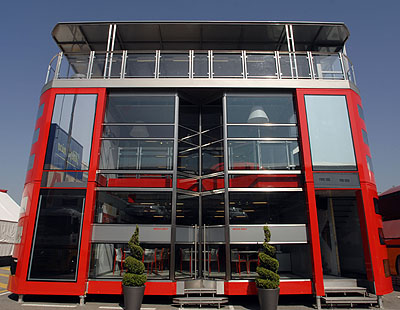


10/05/2007
NEWS STORY
 |
Despite its high-technology forward facing image, the world of Formula 1 is not averse to embracing traditions and one of those traditions is that, even if they don't have wheels and are actually temporary buildings, the structures in the paddock used to house the team offices, hospitality and media facilities are still referred to as 'motorhomes' and the people who work in them as "motorhomers."
Maybe because it has a longer tradition in the sport than any other team, Ferrari stayed with the real motorhome vehicle for longer than most, but for this year, an entirely new unit has been built to replace the previous two vehicles used as the Ferrari media facility and hospitality unit.
And another inevitable tradition is that these vehicles get to make their public debut at the first European race of the season, which is why the new Ferrari facility will be seen for the first time at the Circuit de Catalunya at this weekend's Spanish Grand Prix. It is the only race of the year where the people who actually work in the paddock behave like tourists and spectators, looking in awe at the new creations that they will soon take for granted!
"We started talking about this vehicle two years ago and the instructions to actually proceed came at the end of 2005," said Jon Williams of Procar International, the company that has been providing vehicles for Ferrari for over a decade. "Procar developed the concept which we took to the designer, Fran Cush at Sepang Design, who did all the styling and he has followed the project since its inception. The actual building began in April 2006, under the guidance of an Engineering Consultancy, Frazer Nash, who oversaw the engineering elements of the project, so the entire building of the structure alone has taken one year."
The impetus for the new unit came from the fact that Ferrari wanted to upgrade its existing facilities while increasing the efficiency of its operation. "The idea is to have an integrated unit to be more efficient in all areas; manpower, catering, audio visual, IT and communications and to house everything in one structure," confirms Williams. "The ground floor is dedicated to the media, which has a central dining and press conference area with three offices down the side in one module, for the press officer, a general office and a photographers' office. The upper deck is for team's guests, again with an open seating area in the middle and a VIP meeting room. Furthermore, we have a roof terrace that provides 360 degree viewing, accessible from stairs in the right hand module. It is a large structure that complies with the FOM regulations regarding paddock vehicles. The whole complex is 11.1 metres wide and 14 metres deep. Across the back is a service trailer containing a 7.5 metre long fully fitted catering kitchen. It also houses the generator, water, gas, air conditioning and other services. On top of this service trailer is another module housing a toilet and a shower."
Efficiency of operation has also been the guiding principle behind the task of transporting and erecting the structure. Several paddock units now take many days to build and require a lot of manpower. This is not the case with the Ferrari unit. "The structure is delivered to the race circuit on six vehicles, with seven staff on the operating crew, made up of six drivers and a manager," explains Williams. "It takes just one day to put up the basic structure, with a further day required to fit it out. It is a low manpower project so that it is more easily managed and that was part of the design brief from the very beginning. The interior design was carried out by a company called Country Lab and its designer Francesco Carboncini. The unusual feature is that the structure is made up of large modules that weigh approximately 8000 kilos. That's for the four main stacking modules, with the roof terrace weighing 5500 kilos and the service trailer 22,000 kilos. Erecting the structure requires an 80 ton-metre crane to lift the modules and position them after a survey station goes on site first to check all the levels.
The build has produced some interesting statistics: the construction of the unit used 35 tons of aluminium, 12 tons of steel, 50 kilometres of electrical cable, 3000 litres of diesel fuel tankage and one thousand litres of paint. Just three fibres link all four main modules and these fibres carry all video, audio, data and telephony information. 28 screens including a state of the art LED screen are available for watching available broadcast channels.